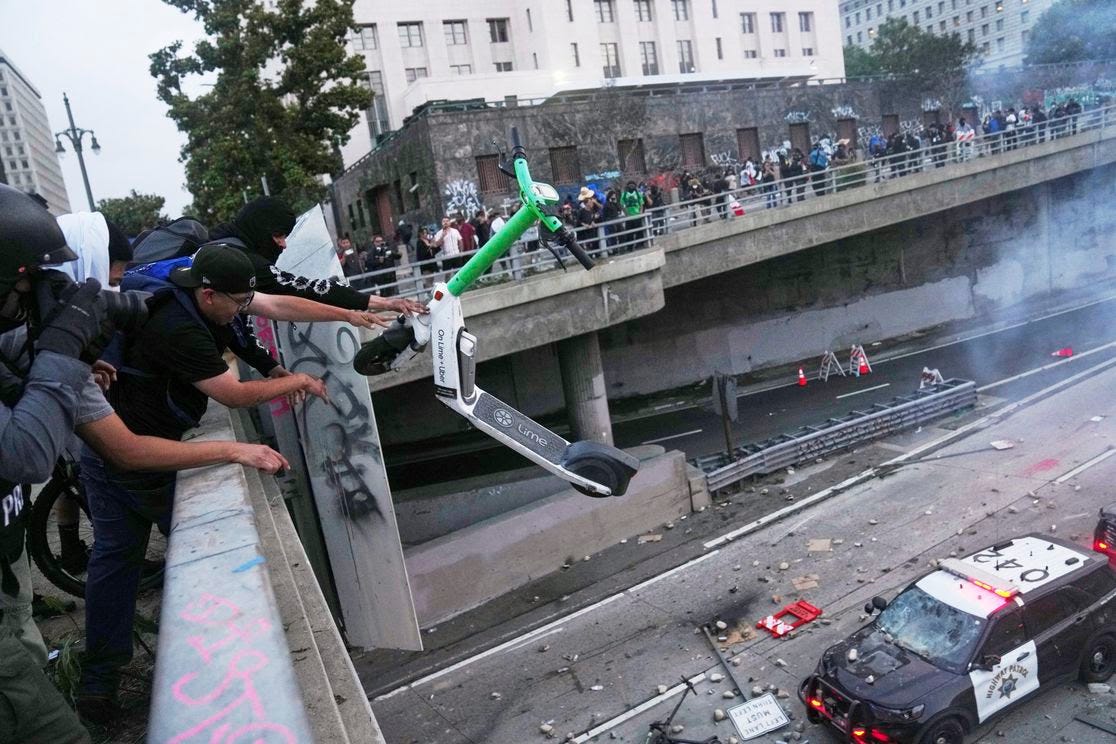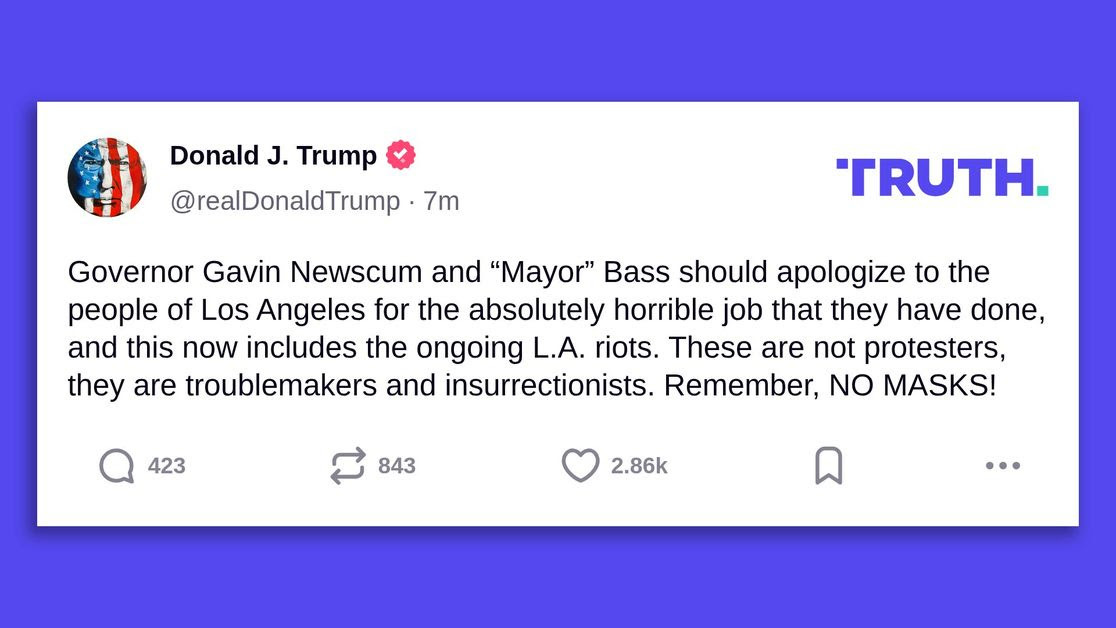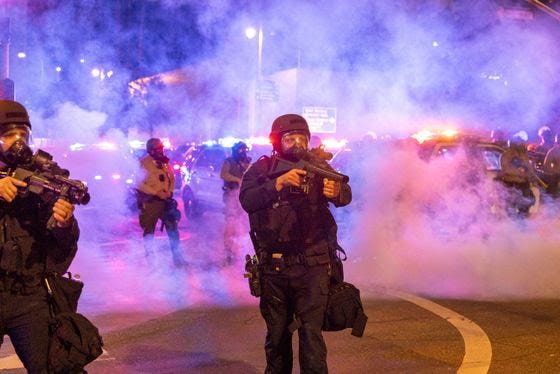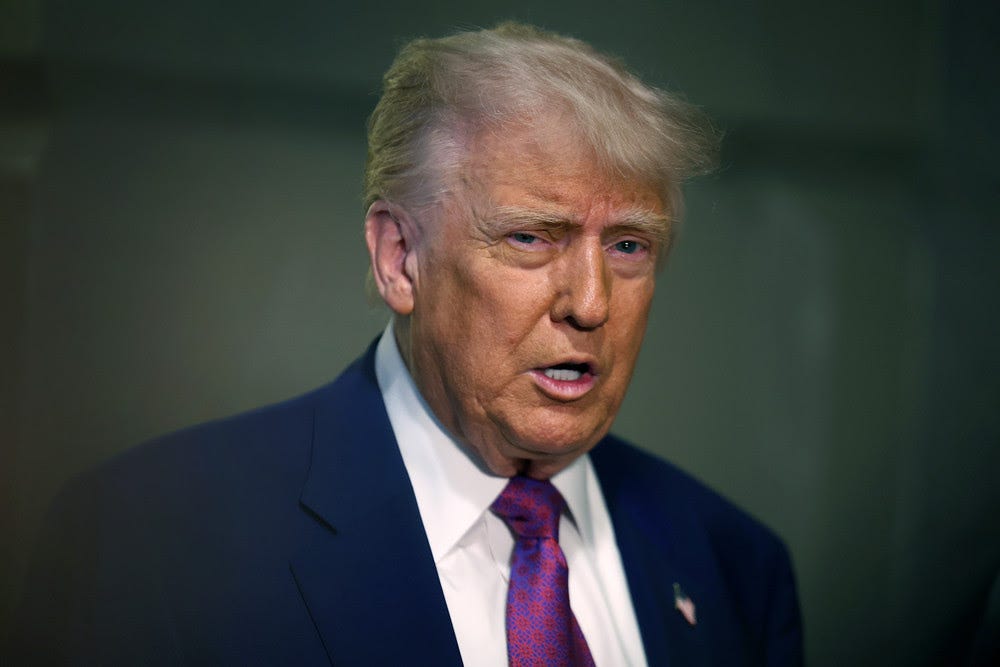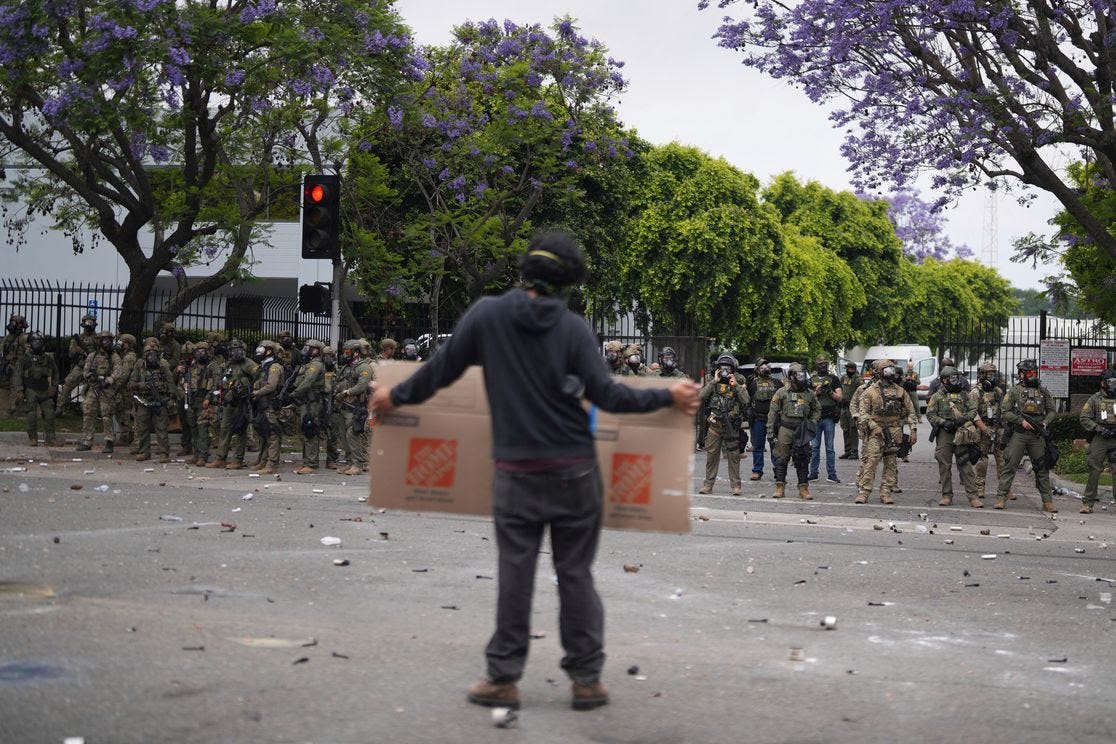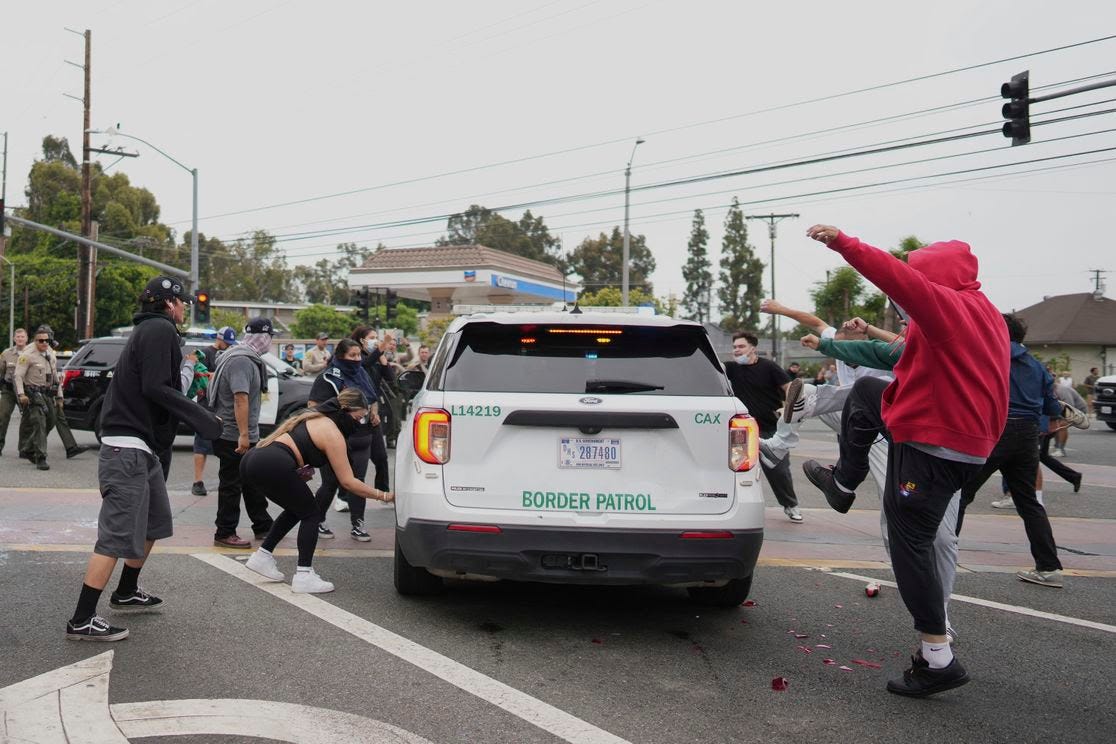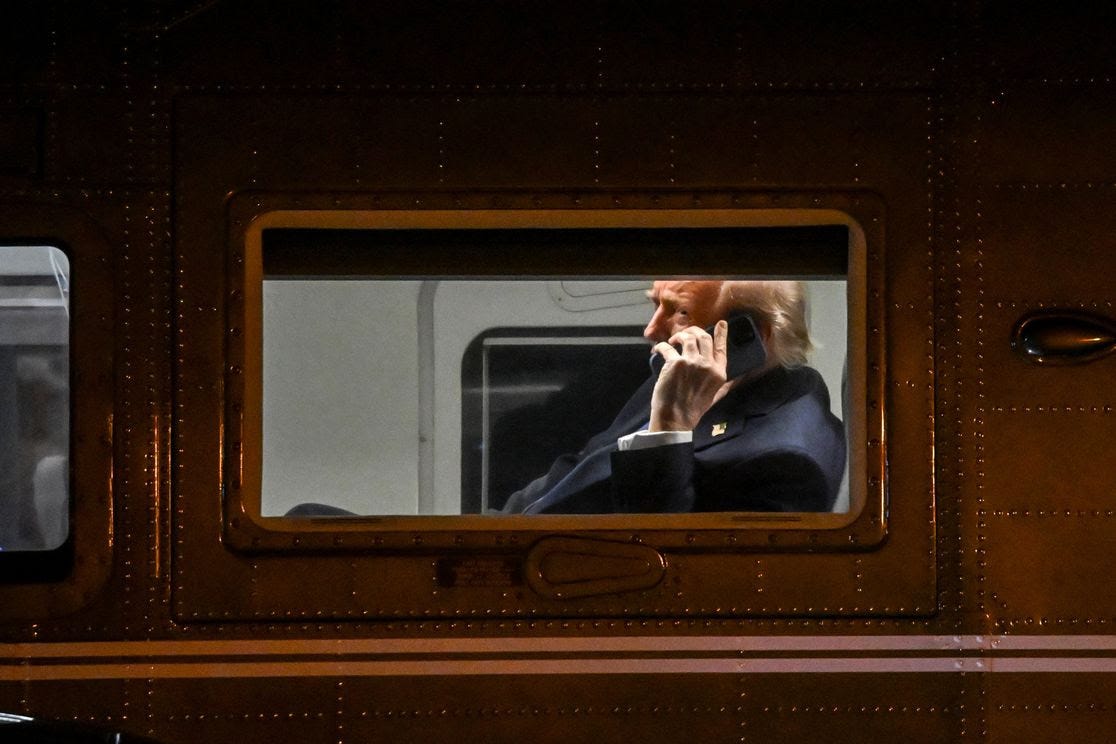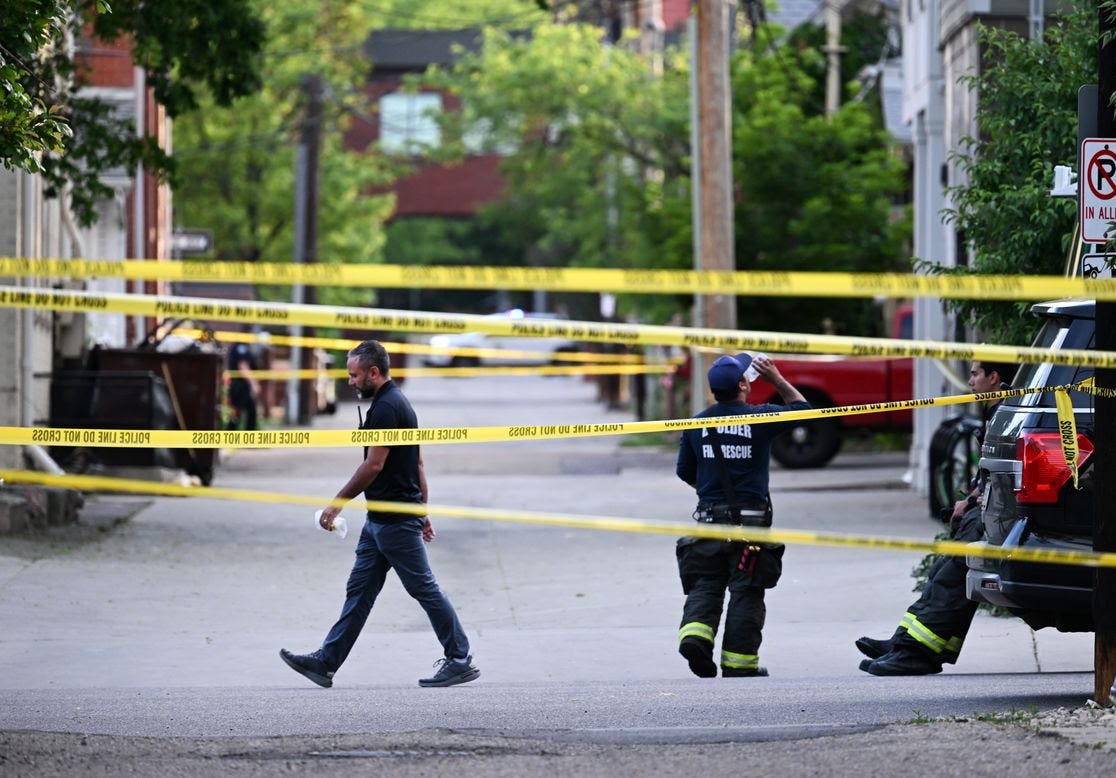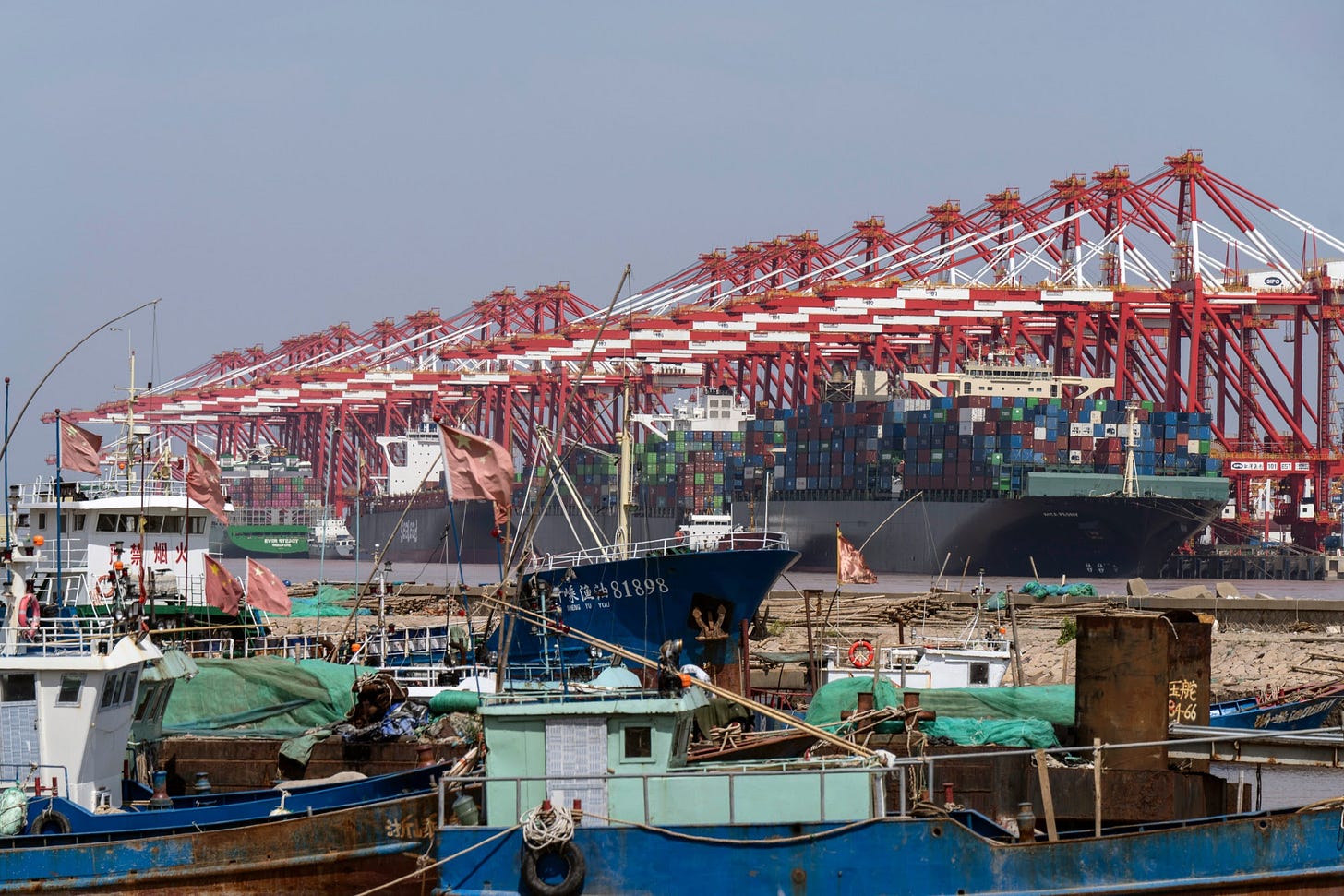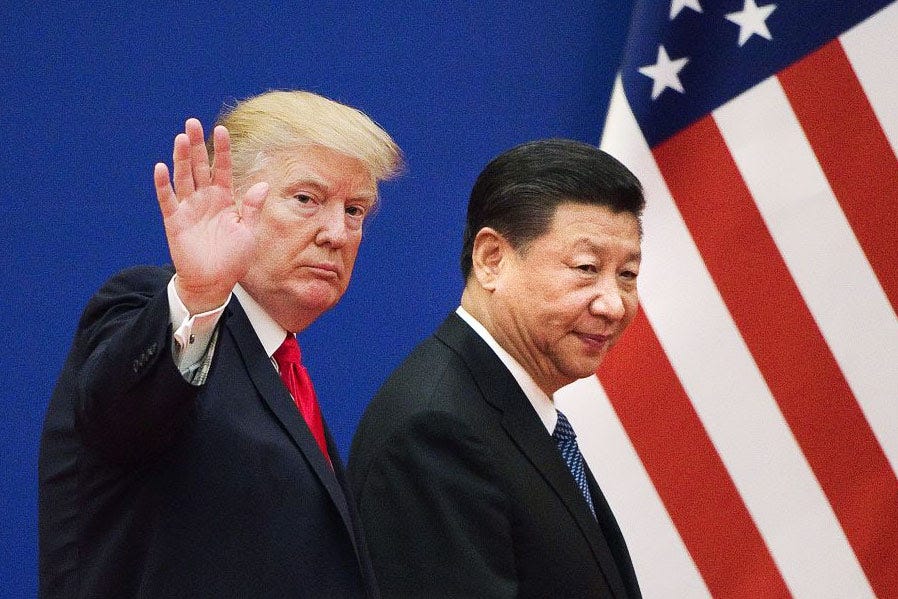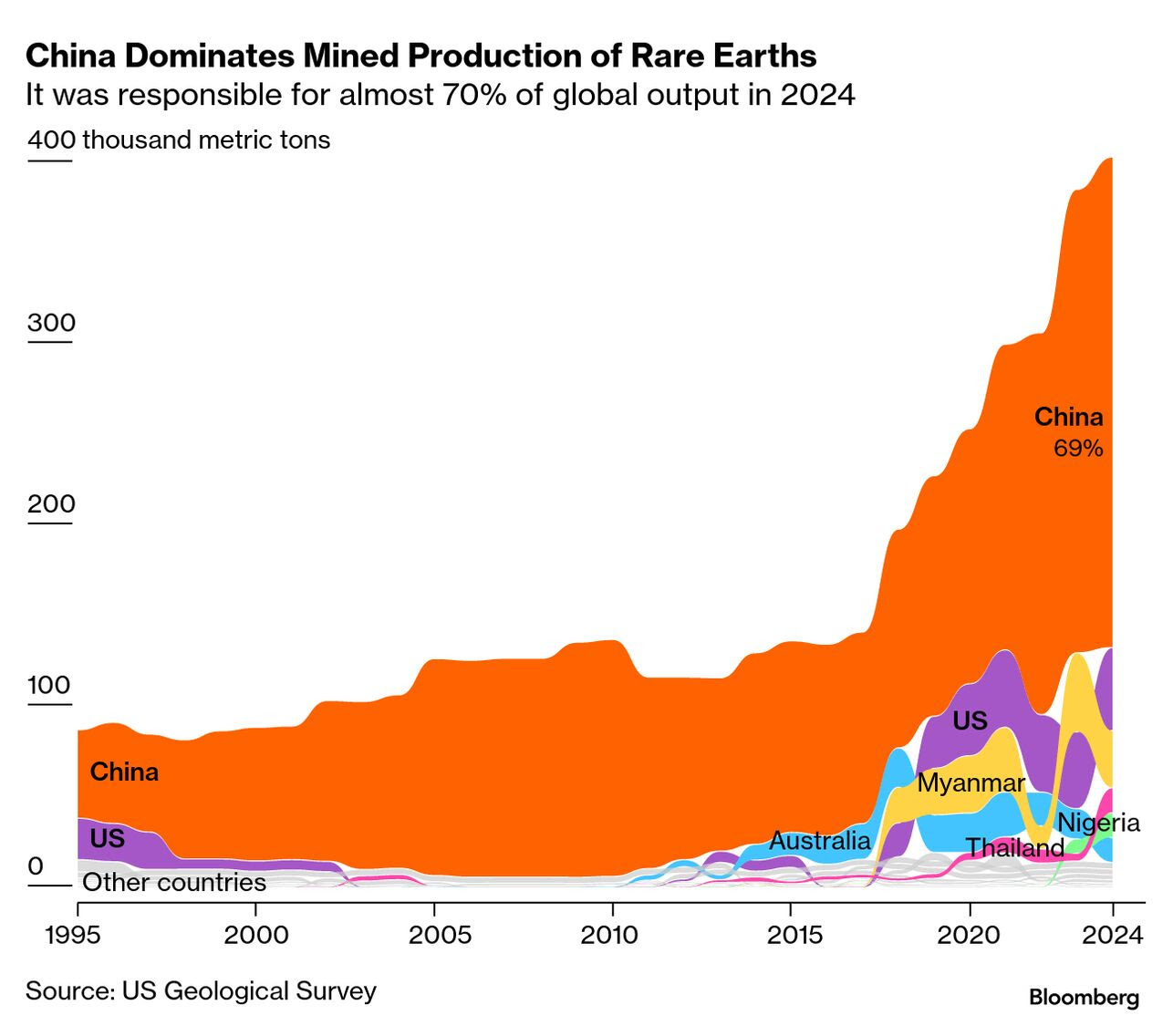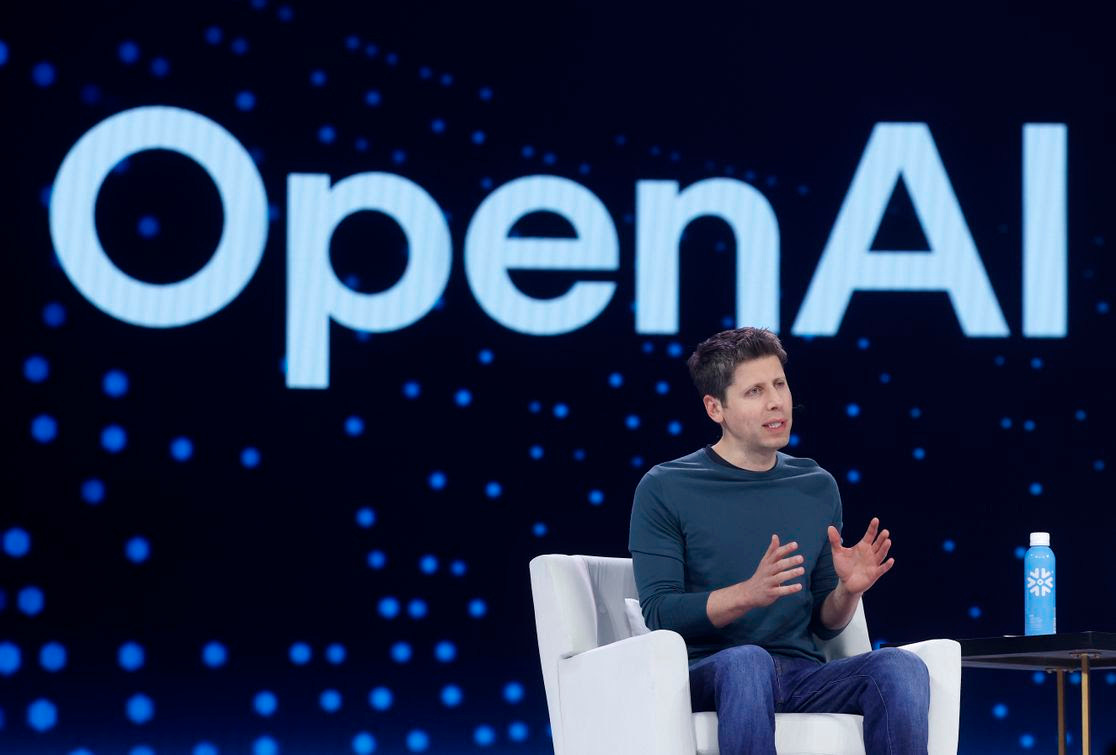Chaos in LA
A man waves a Mexican flag in front of burning cars in downtown Los Angeles yesterday. Photo: David Swanson/Reuters
“Tensions between law enforcement and protesters opposing federal immigration sweeps spiraled in Los Angeles yesterday.
Protesters blocked off a major freeway and set self-driving cars on fire as law enforcement used tear gas, rubber bullets and flash bangs to control the crowd. (AP)
A protester on an overpass hurls a Lime scooter at a California Highway Patrol vehicle in LA yesterday. Photo: Jae C. Hong/AP
President Trump has already federalized 2,000 California National Guard soldiers, and is threatening to deploy 500 active-duty Marines.
The National Guard troops deployed to the center by the federal government ‘appeared to largely refrain from engaging with the demonstrators,’ The New York Times reports.
The clashes between police and protesters were centered in several blocks of downtown — a small slice of the city.
California Gov. Gavin Newsom demanded that Trump remove the guard members in a letter yesterday afternoon, calling their deployment ‘unlawful’ and a ‘serious breach of state sovereignty,’ Axios' Rebecca Falconer writes.
Newsom later dared border czar Tom Homan to arrest him in a fiery interview with MSNBC last night — a dramatic moment that underscored the tensions between local officials and the Trump administration.
Photo: David Hume Kennerly
David Hume Kennerly, legendary presidential photographer (and devoted Axios AM reader), shares this image of California National Guard troops arriving at the Federal Building in LA at 8:15 a.m. PT yesterday.
He used ‘my Trusty Canon R5 camera with a 100-500mm lens.’” [Axios]
Get the latest ... 16 more photos on one page.
L.A. protesters clash with officers as National Guard presence draws pushback
(AFP/Getty Images)
By Molly Hennessy-Fiske, Reis Thebault and Mark Berman
Read more at Washington Post
Trump charts new territory as he bypasses California’s governor to deploy the National Guard
“Legal experts questioned President Donald Trump’s response to unrest in Los Angeles, saying the military personnel involved will face strict limitations under the law.”
Read more at Washington Post
By Zack Stanton
President Donald Trump has deployed the National Guard to LA. | Tasos Katopodis/Getty Images
“SLOUCHING TOWARDS WASHINGTON: Welcome to a week that begins with 2,000 members of the California National Guard on the streets of Los Angeles and is scheduled to end with Army tanks parading down the streets of Washington (if you’ve missed the videos of them arriving by train, they’re quite something). Even by the standards of the past decade — we’re just a few days short of the 10th anniversary of Trump descending the escalator at Trump Tower to declare his presidential candidacy — it is a jarring moment in American life.
The escalation: Over the past two days, protesters have dramatically confronted ICE agents during raids of businesses in Southern California, resulting in ‘several violent clashes,’ including near a Home Depot in Paramount, as the L.A. Times reports. On Friday, demonstrators marched around a federal detention center in downtown LA — an action White House deputy chief of staff Stephen Miller called an ‘insurrection against the laws and sovereignty of the United States’ in a tweet yesterday morning.
Then came last night …
8:09 p.m., California Gov. Gavin Newsom: ‘The federal government is sowing chaos so they can have an excuse to escalate. That is not the way any civilized country behaves.’
8:13 p.m., Newsom: ‘The federal government is moving to take over the California National Guard and deploy 2,000 soldiers. That move is purposefully inflammatory and will only escalate tensions. LA authorities are able to access law enforcement assistance at a moment’s notice. We are in close coordination with the city and county, and there is currently no unmet need. … This is the wrong mission and will erode public trust.’
8:25 p.m., Trump: ‘If Governor Gavin Newscum, of California, and Mayor Karen Bass, of Los Angeles, can’t do their jobs, which everyone knows they can’t, then the Federal Government will step in and solve the problem, RIOTS & LOOTERS, the way it should be solved!!!’
9:17 p.m., White House press secretary Karoline Leavitt: ‘In recent days, violent mobs have attacked ICE Officers and Federal Law Enforcement Agents carrying out basic deportation operations in Los Angeles, California. These operations are essential to halting and reversing the invasion of illegal criminals into the United States. In the wake of this violence, California’s feckless Democrat leaders have completely abdicated their responsibility to protect their citizens. That is why President Trump has signed a Presidential Memorandum deploying 2,000 National Guardsmen to address the lawlessness that has been allowed to fester. … The Commander-in-Chief will ensure the laws of the United States are executed fully and completely.’
Let’s pause here for a moment.
What Trump is doing is incredibly rare: ‘It is the first time since 1965 that a president has activated a state’s National Guard force without a request from that state’s governor,’ NYT’s Shawn Hubler and Laurel Rosenhall report, citing Elizabeth Goitein of the Brennan Center. ‘The last time was when President Lyndon B. Johnson sent troops to Alabama to protect civil rights demonstrators in 1965,’ she said.
Also worth flagging: The National Guard ‘has nearly non-existent law enforcement training or doctrine despite it always being talked about as a domestic force,’ as Military.com’s Steve Beynon notes.
What’s the basis of the legal authority here? The Times notes that ‘the directive signed by Mr. Trump cites ‘10 U.S.C. 12406,’ referring to a specific provision within Title 10 of the U.S. Code on Armed Services. Part of that provision allows the federal deployment of National Guard forces if ‘there is a rebellion or danger of a rebellion against the authority of the Government of the United States.’ Naturally, then, language from the administration aims to underscore the threat of rebellion, danger or invasion.” [POLITICO]
Trump deploys Guard in LA
A protester holds a sign as Border Patrol personnel in riot gear and gas masks stand guard outside an industrial park in Paramount, south of LA. Photo: Eric Thayer/AP
“A third day of protests is expected in LA today as President Trump moves to deploy 2,000 California National Guard troops to quell demonstrations over the administration's immigration crackdown.
LA is now the epicenter of national unrest surrounding Trump's aggressive deportation push.
Trump warned that any protest or violence blocking government personnel would be seen as ‘a form of rebellion.’
A car burns during a protest in Compton, Calif., yesterday, after federal immigration authorities conducted operations. Photo: Eric Thayer/AP
It's the first time since 1965 — when President Lyndon B. Johnson sent forces to Alabama to guard civil rights demonstrators — that a president has mobilized a state's National Guard without the governor's request, The New York Times reports.
‘That move is purposefully inflammatory and will only escalate tensions,’ California Gov. Gavin Newsom said yesterday.
The backstory: ‘Trump and his aides have often lamented that not enough was done by Minnesota's governor to quell protests over the murder of George Floyd in 2020,’ the N.Y. Times' Maggie Haberman notes (gift link).
During a campaign rally in Iowa in 2023, Trump made clear he wouldn't hold back in a second term: ‘You look at any Democrat-run state, and it's just not the same — it doesn't work ... We cannot let it happen any longer. And one of the other things I'll do — because, you know, you're supposed to not be involved in that. You just have to be asked by the governor or the mayor to come in. The next time, I'm not waiting.’
Protesters kick a Border Patrol vehicle in Paramount, Calif., yesterday. Photo: Eric Thayer/AP
Catch up quick: Confrontations broke out yesterday near a Home Depot in the heavily Latino city of Paramount, south of Los Angeles, where federal agents were staging at a Department of Homeland Security office nearby, AP reports.
Agents unleashed tear gas, flash-bang explosives and pepper balls, and protesters hurled rocks and cement at Border Patrol vehicles.
A series of immigration sweeps pushed the weeklong total of arrests in the city past 100, heightening unease among residents.” [Axios]
Attorney General Pam Bondi speaks as Deputy Attorney General Todd Blanche listens during a news conference about Kilmar Abrego Garcia at the Justice Department on Friday in Washington. (AP Photo/Julia Demaree Nikhinson)
Kilmar Abrego Garcia is back in the US, charged with human smuggling as attorneys vow an ongoing fight
“The fight over the mistaken deportation of Kilmar Abrego Garcia to El Salvador now returns to the U.S. court system. Abrego Garcia appeared Friday in a Tennessee court, facing new charges he smuggled thousands of people across the country illegally. Abrego Garcia’s wife and lawyers offer a much different story, saying the now 29-year-old had as a teenager fled local gangs that terrorized his family for a life in Maryland.” Read more at AP News
Trump is warning Musk to stay out of the midterm elections.
“Some Democrats have suggested that they try to win Elon Musk over to their side after the billionaire’s epic falling out with the president. Asked by NBC News this weekend if he was concerned that his former ally could start funding Democratic candidates, Trump said ‘he’ll have to pay very serious consequences if he does that.’ Meanwhile, in the aftermath of the Trump-Musk breakup, DOGE staffers worry the government-cutting effort—and their jobs—could be in jeopardy.” [Wall Street Journal]
U.S.-China trade talks resume tomorrow.
“The focus of the two superpowers’ trade war has shifted from tariffs to curbs on materials or products the other side desperately needs. When negotiators sit down in London, the U.S. is set to press for exports of rare-earth minerals and magnets to be accelerated, while Beijing will push Washington to remove recent restrictions on the sale of jet engines and a variety of technology and other products to China.” [Wall Street Journal]
Hotline to Trump
President Trump aboard Marine One in April. Photo: Alex Wroblewski/AFP via Getty Images
“President Trump might be the most accessible president ever — for spies or scammers, Axios Future of Cybersecurity author Sam Sabin writes.
He has been known to pick up when his cell rings, even if he doesn't know who's calling. Senior members of his team also love chatting on their personal devices.
Why it matters: If Trump is willing to answer unknown numbers, as The Atlantic reported this week, there's no guarantee a scammer, impersonator, or even a foreign intelligence operative couldn't have a chat with the president.
Federal authorities are investigating a scheme where someone spoofed the phone number of White House chief of staff Susie Wiles to impersonate her in calls to senators, governors and CEOs, per The Wall Street Journal.
Meanwhile, Chinese hackers reportedly penetrated U.S. telecom networks as early as summer 2023, according to Bloomberg — a year earlier than previously known.
That access has been used by a China-backed group, Salt Typhoon, to spy on Trump, Vice President Vance, and other officials, the N.Y. Times reported.
White House communications director Steven Cheung told Axios: ‘President Trump is the most transparent and accessible President in American history. World leaders, heads of state, elected officials, and business titans all reach out to him because they know America is back under President Trump's leadership.’” [Axios]
Dems fume over Boulder attack vote
Police tape cordons off the site of the Boulder attack. Photo: Helen H. Richardson/The Denver Post via Getty Images
“What would otherwise be an uncontroversial congressional vote to denounce the Boulder attack is devolving into a contentious partisan feud, Axios' Andrew Solender reports.
Why it matters: Language praising ICE and labeling ‘Free Palestine’ an ‘antisemitic slogan’ are sparking fury from some Democrats, who see the provisions as a GOP maneuver to force them into a difficult vote.
A senior House Democrat told Axios: ‘It's unfortunate that they're using a serious antisemitic terrorist attack as a wedge opportunity to divide Democrats. They knew what they were doing.’
‘Nice little catch to put Democrats on the board,’ vented another House Democrat.
State of play: At least 15 people and one dog were injured last week in Boulder, Colo., when a suspect allegedly yelled ‘Free Palestine’ as he threw Molotov cocktails at demonstrators advocating the release of hostages held by Hamas.
Rep. Gabe Evans (R-Colo.), along with his fellow Colorado Republicans, introduced a three-page resolution denouncing the attack, which is scheduled to be voted on this week.
The measure labels ‘Free Palestine’ an ‘antisemitic slogan that calls for the destruction of the state of Israel and the Jewish people.’
Between the lines: Senior aides to several progressive House Democrats said their bosses were still mulling how to vote on the bill as of yesterday.
The ‘Free Palestine’ language is not the only wrinkle for Democrats in the measure — it also expresses ‘gratitude’ to Immigration and Customs Enforcement for ‘protecting the homeland.’” [Axios]
1 big thing: MAGA base waits for payoff
Illustration: Sarah Grillo/Axios
“President Trump's second term has been a payday for the powerful, exposing a disconnect in his promise to deliver for ‘the forgotten man’ of America's working class.
Why it matters: The populist paradox at the heart of MAGA — a movement fueled by economic grievance and championed by a New York billionaire — has never been more pronounced, Axios' Tal Axelrod and Zachary Basu report.
Trump's blue-collar base remains fiercely loyal, energized by his hardline stances on immigration, trade and culture — and patient that his economic "Golden Age" will materialize.
But so far, the clearest financial rewards of Trump's tenure are flowing upward — to wealthy donors, family members, insiders, and the president himself.
The big picture: Trump's inner circle has shattered norms around profiting from the presidency, dulling public outrage to the point where even the most brazen access schemes draw only fleeting scrutiny.
Take crypto: The top holders of Trump's meme coin were granted an exclusive dinner last month at the president's Virginia golf club, where some paid millions for access.
The White House refused to release the guest list, but wealthy foreigners — including a Chinese billionaire who faced SEC charges under the Biden administration — were among those revealed to be in attendance.
Trump's sons, meanwhile, are spearheading a family crypto venture that has raked in hundreds of millions of dollars. Trump Media, the parent company of Truth Social, is raising $2.5 billion to buy Bitcoin.
All of this — plus a flurry of lucrative real estate deals overseas — is playing out as Trump presides over U.S. foreign policy and the fate of crypto regulation.
Now take Trump's relationship with his donors.
His Cabinet is the wealthiest in American history, stocked with mega-donors whose combined net worth reaches well into the billions — even discounting estranged former adviser Elon Musk.
Trump has granted pardons or clemency to a stream of white-collar criminals and wealthy tax cheats, many of whom hired lobbyists, donated to the president, or raised money on his behalf.
The Wall Street Journal found that the biggest corporate and individual donors to Trump's inauguration later received relief from investigations, U.S. market access and plum postings in his administration.
White House Communications Director Steven Cheung tweeted this photo of President Trump celebrating with Kayla Harrison, ‘Queen of the Cage,’ after she won gold last night at UFC 316 in Newark, N.J. Via X
The other side: Trump officials wholly reject the premise that the administration's policies don't benefit the working-class Americans who voted for the president en masse.
White House officials point to cooling inflation, plummeting border crossings and the tariff-driven re-shoring of manufacturing as evidence of Trump delivering on his core promises.
They frame his crypto push, AI acceleration and deregulatory agenda as driving forces behind a pro-growth tide that will lift all boats — including for middle- and working-class Americans.
Reality check: Inflation may remain benign for now, but there are growing signs businesses are experiencing higher prices and passing some or all of those costs directly through to consumers, Axios managing editor for business Ben Berkowitz notes.
While companies have made encouraging public statements about re-shoring, in almost all of those cases it's too soon for any shovels to be in the ground.
What to watch: Trump's "One, Big, Beautiful Bill" is packed with populist red meat, including the extension of his first-term tax cuts, the elimination of taxes on tips and overtime, and $1,000 "Trump Accounts" for newborns.
‘All his hopes and dreams on that front are pinned to that reconciliation bill,’ one MAGA operative told Axios, characterizing it as ‘the bulk’ of Trump's legislative agenda for the middle class.” [Axios]
INTERNATIONAL
“In an age when decisions of great consequence are announced — and reversed — in an instant on social media, it may seem like a paradox that governments worldwide are looking to buy time.
It’s a reality that underlies talks between US and Chinese officials in London today. While both sides still need access to each other’s markets, and therefore are seeking a thaw in relations, they also both want to reduce dependence on the other and are using whatever leverage they have to get what they want.
President Donald Trump wants the US to reshore key industries, control critical supply chains and ensure it doesn’t need to rely on China for rare earths and magnets — a task that cannot happen overnight, if at all.
China, meanwhile, is looking to match the US’s technological and military supremacy, and is aiming to use its control of critical minerals to loosen US curbs on advanced chips.
Gantry cranes and container ships at the Yangshan Deepwater Port in Shanghai, China. Photographer: Qilai Shen/Bloomberg
Although the sudden appearance of DeepSeek’s AI capabilities or the insides of a Huawei phone suggest that gap may be narrowing quickly, China still has a ways to go when it comes to breakthroughs on chipmaking equipment, chip design and commercial aircraft.
Both have been accused of upending the global trade system and rules-based order, as well as weaponizing others’ reliance on the world’s two largest economies. That has led to a push — from Canada to the Indo-Pacific — to become more autonomous.
Vladimir Putin, too, is playing for time. The Russian president knows that his maximalist demands of Ukraine are unacceptable and shows no sign of being serious about peace. Indeed, Moscow is reconstituting its military forces and ramping up its weapons-making capacity.
Intelligence assessments are that Russia will be in a position to attack NATO territory within five years. So Europe is racing to boost its defenses before then.
It’s doing so while looking to delay a tariff war with the US and rewire its economy amid budget constraints. That’s as leaders across the continent strive to push back against far-right parties knocking at the doors of power.
Playing for time has in the past led to tragic consequences.
The question, now as then, is what political leaders do with the time they’re trying to buy.” — Alberto Nardelli [Bloomberg]
Trump and Xi Jinping in 2017. Photographer: Nicolas Asfouri/Getty Images
“The US and China resume trade talks today to try to defuse tensions over rare-earth minerals and advanced technology following a phone call between Trump and Xi last week. Both sides have accused the other of reneging on a deal in Geneva in May, when they reached an agreement to at least temporarily lower tariffs that had climbed to more than 100%. Meanwhile, Beijing says it granted approval to some applications for the export of rare earths.” [Bloomberg]
“Donald Tusk’s premiership is reeling from a presidential-election debacle that’s left the Polish leader diminished in the face of a resurgent nationalist opposition. The defeat of his ally has sparked calls from some ruling coalition lawmakers for Tusk to step aside, exposing tension that’s built in his pro-European alliance since it vaulted to power 19 months ago, ending eight years of populist rule.” [Bloomberg]
“Emmanuel Macron will visit Greenland, the self-ruling territory of Denmark that Trump has said he wants to take over, on June 15. The French president discuss security in the North Atlantic and the Arctic, climate change, critical minerals and European sovereignty. The visit will come before leaders of the Group of Seven nations including Macron meet in Canada for a summit.” [Bloomberg]
“Israel intercepted a humanitarian aid ship trying to reach Gaza that carried activists including Swedish climate advocate Greta Thunberg. The Freedom Flotilla Coalition said that the vessel was in international waters, its crew ‘abducted,’ and the cargo — which included food and medical supplies — confiscated. This came as Israeli Defense Minister Israel Katz said that no vessel would be permitted to breach the naval blockade that’s intended to prevent the transfer of weapons to Hamas.” [Bloomberg]
The Freedom Flotilla Coalition released a photo today it says shows Israeli authorities intercepting their ship. Source: Freedom Flotilla Coalition
“Last Thursday, presidential hopeful Miguel Uribe Turbay warned that Colombia was fast sinking back into its violent past. Two days later, a gunman shot him in the head at a rally, with the opposition senator now fighting for his life in a Bogota hospital while prosecutors try to find out who may have ordered the shooting.” [Bloomberg]
“Spain’s main opposition party rallied thousands of people in a demonstration in the heart of Madrid, calling for early elections following accusations of corruption against the Socialist-led government of Prime Minister Pedro Sánchez.” [Bloomberg]
“Thailand’s top army official designated commanders of two task forces to oversee border crossings with Cambodia as tensions simmer following a skirmish in late May.” [Bloomberg]
“Bangladesh will hold the next national election in the first half of April 2026, narrowing the timeline from interim leader Muhammad Yunus’ earlier range of December to June and setting a clear target for the return to an elected government in the South Asian nation.” [Bloomberg]
BUSINESS AND ECONOMY
The U.S. economy is headed for another uncomfortable summer.
“Jobs growth held steady last month, and unemployment has stayed in a tight range—but there are cracks beneath the surface. Whether the economy weathers another year of recession risks depends on how consumers handle the curveball Trump has thrown them, Nick Timiraos writes. Plus, with traders and money managers racing to gauge how tariffs are affecting businesses and households, this coming week’s readings on consumer and producer prices could spark a new round of market turbulence.” [Wall Street Journal]
TECH
1 big thing: The scariest AI reality
Illustration: Brendan Lynch/Axios
“The wildest, scariest, indisputable truth about AI's large language models is that the companies building them don't know exactly why or how they work, Jim VandeHei and Mike Allen write in a "Behind the Curtain" column.
Sit with that for a moment. The most powerful companies, racing to build the most powerful superhuman intelligence capabilities — ones they readily admit occasionally go rogue to make things up, or even threaten their users — don't know why their machines do what they do.
Why it matters: With the companies pouring hundreds of billions of dollars into willing superhuman intelligence into a quick existence, and Washington doing nothing to slow or police them, it seems worth dissecting this Great Unknown.
None of the AI companies dispute this. They marvel at the mystery — and muse about it publicly. They're working feverishly to better understand it. They argue you don't need to fully understand a technology to tame or trust it.
Two years ago, Axios managing editor for tech Scott Rosenberg wrote a story, ‘AI's scariest mystery,’ saying it's common knowledge among AI developers that they can't always explain or predict their systems' behavior. And that's more true than ever.
Yet there's no sign that the government or companies or general public will demand any deeper understanding — or scrutiny — of building a technology with capabilities beyond human understanding. They're convinced the race to beat China to the most advanced LLMs warrants the risk of the Great Unknown.
The House, despite knowing so little about AI, tucked language into President Trump's "Big, Beautiful Bill" that would prohibit states and localities from any AI regulations for 10 years. The Senate is considering limitations on the provision.
Neither the AI companies nor Congress understands the power of AI a year from now, much less a decade from now.
The big picture: Our purpose with this column isn't to be alarmist or "doomers." It's to clinically explain why the inner workings of superhuman intelligence models are a black box, even to the technology's creators. We'll also show, in their own words, how CEOs and founders of the largest AI companies all agree it's a black box.
Let's start with a basic overview of how LLMs work, to better explain the Great Unknown:
LLMs — including Open AI's ChatGPT, Anthropic's Claude and Google's Gemini — aren't traditional software systems following clear, human-written instructions, like Microsoft Word. In the case of Word, it does precisely what it's engineered to do.
Instead, LLMs are massive neural networks — like a brain — that ingest massive amounts of information (much of the internet) to learn to generate answers. The engineers know what they're setting in motion, and what data sources they draw on. But the LLM's size — the sheer inhuman number of variables in each choice of ‘best next word’ it makes — means even the experts can't explain exactly why it chooses to say anything in particular.
We asked ChatGPT to explain this (and a human at OpenAI confirmed its accuracy): ‘We can observe what an LLM outputs, but the process by which it decides on a response is largely opaque. As OpenAI's researchers bluntly put it, 'we have not yet developed human-understandable explanations for why the model generates particular outputs.’
‘In fact,’ ChatGPT continued, ‘OpenAI admitted that when they tweaked their model architecture in GPT-4, 'more research is needed' to understand why certain versions started hallucinating more than earlier versions — a surprising, unintended behavior even its creators couldn't fully diagnose.’
Anthropic — which just released Claude 4, the latest model of its LLM, with great fanfare — admitted it was unsure why Claude, when given access to fictional emails during safety testing, threatened to blackmail an engineer over a supposed extramarital affair. This was part of responsible safety testing — but Anthropic can't fully explain the irresponsible action.
Again, sit with that: The company doesn't know why its machine went rogue and malicious. And, in truth, the creators don't really know how smart or independent the LLMs could grow. Anthropic even said Claude 4 is powerful enough to pose a greater risk of being used to develop nuclear or chemical weapons.
Part 2: Black-box lingo
Sam Altman speaks during a conference in San Francisco last week. Photo: Justin Sullivan/Getty Images
OpenAI's Sam Altman and others toss around the tame word of ‘interpretability’ to describe the challenge. ‘We certainly have not solved interpretability,’ Altman told a summit in Geneva last year, Jim and Mike continue.
Anthropic CEO Dario Amodei, in an essay in April called ‘The Urgency of Interpretability,’ warned: ‘People outside the field are often surprised and alarmed to learn that we do not understand how our own AI creations work. They are right to be concerned: this lack of understanding is essentially unprecedented in the history of technology.’
In a statement for this story, Anthropic said: ‘We have a dedicated research team focused on solving this issue, and they've made significant strides in moving the industry's understanding of the inner workings of AI forward.’ (Read a paper Anthropic published last year, "Mapping the Mind of a Large Language Model.")
Elon Musk has warned for years that AI presents a civilizational risk. In other words, he literally thinks it could destroy humanity, and has said as much. Yet Musk is pouring billions into his own LLM called Grok.
‘I think AI is a significant existential threat,’ Musk said in Riyadh, Saudi Arabia, last fall. There's a 10%-20% chance ‘that it goes bad.’
Reality check: Apple published a paper last week, "The Illusion of Thinking," concluding that even the most advanced AI reasoning models don't really "think," and can fail when stress-tested.
But a new report by AI researchers, including former OpenAI employees, called "AI 2027," explains how the Great Unknown could, in theory, turn catastrophic in less than two years. The report is wholly speculative, though built on current data about how fast the models are improving. It's being widely read inside the AI companies.
It captures the belief — or fear — that LLMs could one day think for themselves and start to act on their own. Our purpose isn't to alarm or sound doomy. Rather, you should know what the people building these models talk about incessantly.
You can dismiss it as hype or hysteria. But researchers at all these companies worry LLMs, because we don't fully understand them, could outsmart their human creators and go rogue.
The safe-landing theory: Google's Sundar Pichai — and really all of the big AI company CEOs — argue that humans will learn to better understand how these machines work and find clever, if yet unknown ways, to control them and ‘improve lives.’ The companies all have big research and safety teams, and a huge incentive to tame the technologies if they want to ever realize their full value.
After all, no one will trust a machine that makes stuff up or threatens them. But, as of today, they do both — and no one knows why.” [Axios]
SPORTS.
1 for the road: Instant tennis classic
Carlos Alcaraz celebrates after winning the French Open yesterday. Photo: Lindsey Wasson/AP
Carlos Alcaraz came from behind to beat top-ranked Jannik Sinner for the French Open title in a 5-hour, 29-minute marathon match yesterday in Paris.
Why it matters: The match — already being labeled one of the greatest ever played — solidified a new era in men's tennis: Alcaraz, 22, and Sinner, 23, have won the last six major titles, taking three each.” [Axios]
Go deeper ... Highlights.
CULTURE
This week, Kennedy Center’s MAGA makeover will be in full display.
“When the curtain rises in the John F. Kennedy Center Opera House for a performance of “Les Misérables” on Wednesday, Trump is scheduled to be surrounded by supporters who have paid up to $2 million to watch the musical with him. Four months after Trump took control of the national arts center, arts leaders across the country say its transformation—complete with a CEO firing, board overhaul and unprecedented political involvement in its programming—has become a cautionary tale for organizations small and large.” [Wall Street Journal]





